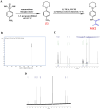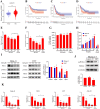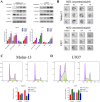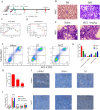A novel organic arsenic derivative MZ2 remodels metabolism and triggers mtROS-mediated apoptosis in acute myeloid leukemia
- PMID: 36056952
- PMCID: PMC11797718
- DOI: 10.1007/s00432-022-04333-2
A novel organic arsenic derivative MZ2 remodels metabolism and triggers mtROS-mediated apoptosis in acute myeloid leukemia
Abstract
Purpose: Acute myeloid leukemia (AML) is one of the most common neoplasms in adults, and it is difficult to achieve satisfactory results with conventional drugs. Here, we synthesized a novel organic arsenic derivative MZ2 and evaluated its ability to remodel energy metabolism to achieve anti-leukemia.
Methods: MZ2 was characterized by the average 1-min full mass spectra analysis. Biological methods such as Western blot, qPCR, flow cytometry and confocal microscopy were used to assess the mode and mechanism of MZ2-induced death. The in vivo efficacy of MZ2 was assessed by constructing a patient-derived xenograft (PDX) AML model.
Results: Unlike the precursor organic arsenical Z2, MZ2 can effectively reduce the level of aerobic glycolysis. Our in-depth found that MZ2 inhibited the expression of PDK2 in a dose-dependent manner and did not affect the expression of LDHA, another key enzyme of the glycolytic pathway. MZ2 reconstituted energy metabolism to induce the generation of mitochondrial ROS (mtROS) and then triggerd intrinsic apoptosis pathway. We also assessed whether MZ2 generates autophagy and results showed that MZ2 can induce autophagy of AML cells, which may be associated with the precursor organic arsenic drug. In vivo, MZ2 effectively attenuated leukemia progression in mice, and immunohistochemical results suggested its PDK2 inhibitory effect.
Conclusion: In summary, the novel organic arsine derivative MZ2 exhibited excellent anti-tumor effects in acute myeloid leukemia, which may provide a potential strategy for the treatment of acute myeloid leukemia.
Keywords: Apoptosis; Leukemia; Organic arsine; Pyruvate dehydrogenase kinase 2; Warburg effect.
© 2022. The Author(s), under exclusive licence to Springer-Verlag GmbH Germany, part of Springer Nature.
Conflict of interest statement
The authors declare no conflict of interest regarding the publication of this manuscript.
Figures









Similar articles
-
Lactate dehydrogenase A-coupled NAD+ regeneration is critical for acute myeloid leukemia cell survival.Cancer Metab. 2025 May 19;13(1):22. doi: 10.1186/s40170-025-00392-4. Cancer Metab. 2025. PMID: 40390151 Free PMC article.
-
The Black Book of Psychotropic Dosing and Monitoring.Psychopharmacol Bull. 2024 Jul 8;54(3):8-59. Psychopharmacol Bull. 2024. PMID: 38993656 Free PMC article. Review.
-
Signs and symptoms to determine if a patient presenting in primary care or hospital outpatient settings has COVID-19.Cochrane Database Syst Rev. 2022 May 20;5(5):CD013665. doi: 10.1002/14651858.CD013665.pub3. Cochrane Database Syst Rev. 2022. PMID: 35593186 Free PMC article.
-
Orthodontic treatment for crowded teeth in children.Cochrane Database Syst Rev. 2021 Dec 31;12(12):CD003453. doi: 10.1002/14651858.CD003453.pub2. Cochrane Database Syst Rev. 2021. PMID: 34970995 Free PMC article.
-
Systemic pharmacological treatments for chronic plaque psoriasis: a network meta-analysis.Cochrane Database Syst Rev. 2021 Apr 19;4(4):CD011535. doi: 10.1002/14651858.CD011535.pub4. Cochrane Database Syst Rev. 2021. Update in: Cochrane Database Syst Rev. 2022 May 23;5:CD011535. doi: 10.1002/14651858.CD011535.pub5. PMID: 33871055 Free PMC article. Updated.
References
MeSH terms
Substances
Grants and funding
LinkOut - more resources
Full Text Sources
Medical
Miscellaneous

